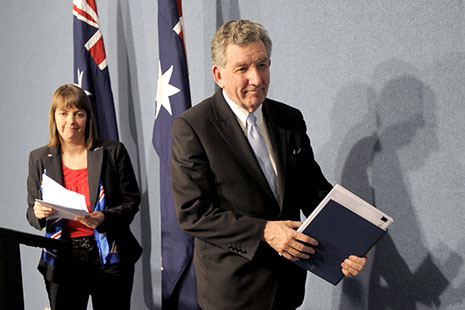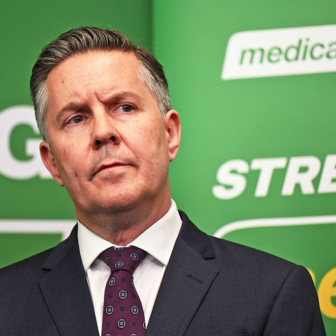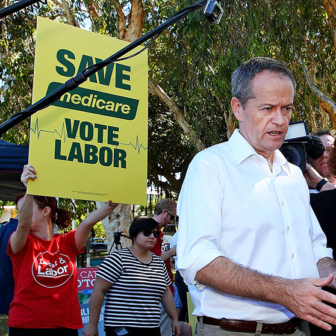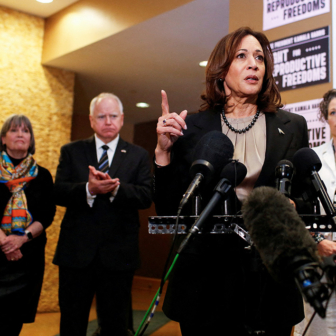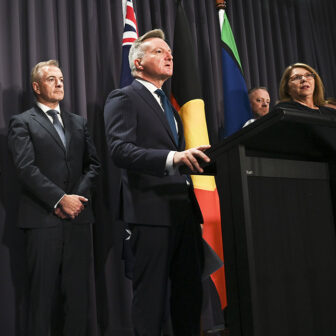WHO DO you trust when it comes to advice about swine flu, and whether you or members of your family should be vaccinated? Is it your GP, your neighbour, the professor on the television or the government’s advertising campaign? Why do you trust them? How much do you trust them?
Questions about people’s trust in public health messages – including what it takes to win or lose it – are at the heart of a recent article in JAMA, the journal of the American Medical Association, which details examples from across the globe in which trust in the safety of vaccines has been dented, often to the detriment of public health. It’s a timely piece, given the current push for parents in Australia to make sure their children are vaccinated against influenza as they return to school.
It’s also timely in the light of a series of recent developments that might have undermined public trust in official responses to pandemic influenza. While we were marking Australia Day, a senior official from the World Health Organization was defending his organisation’s management of the pandemic at a public hearing convened in Strasbourg by the Council of Europe.
Keiji Fukuda, special adviser on pandemic influenza to the director-general of WHO (and formerly head of the influenza epidemiology unit at the Centers for Disease Control and Prevention in the United States), was responding to allegations that WHO had “faked” a pandemic on the basis of overly close ties with companies that make influenza vaccines and treatments.
The chair of the council’s health committee, Wolfgang Wodarg, a German epidemiologist-turned-MP, told the hearing that around $18 billion had been spent on the pandemic worldwide and that millions were vaccinated “for no good reason.” According to Wodarg, “The definition of a pandemic was changed by the WHO last May. It was only this change of definition which made it possible to transform a run-of-the-mill flu into a worldwide pandemic – and made it possible for the pharmaceutical industry to transform this opportunity into cash, under contracts which were mainly secret.”
Equally critical of the response to swine flu was Ulrich Keil, director of the WHO Collaborating Centre for Epidemiology at the University of Münster. “We are witnessing a gigantic misallocation of resources in terms of public health,” he told the hearing.
A day later, in Canada’s Globe and Mail, two senior doctors wrote that the “ballyhoo” over the swine flu was due to WHO’s “rigid adherence to pre-existing pandemic plans” rather than to any conspiracy theory involving pharmaceutical companies, though the consequences were no less serious. Richard Schabas, a former chief medical officer of health in Ontario, and Neil Rau, an infectious diseases specialist at the University of Toronto, argued that the WHO had made a subtle but important change in its definition of pandemic. “It dropped the key requirements that a pandemic virus had to be completely novel – an antigenic shift – and cause widespread and severe disease,” they wrote. “Almost immediately, as luck had it, a virus appeared that fit the new pandemic definition – but not the old one.”
The Canadian doctors said that the H1N1 outbreak peaked in their neck of the woods in October, and disease rates dropped off rapidly in North America. “Any benefit from immunising healthy people had virtually vanished by mid November, the very time when the vaccine became readily available to all,” they wrote. “Speculation about a serious ‘third wave’ is fading fast, as high population levels of immunity make it implausible.” But instead of spreading this good news, they say, “the current risk is exaggerated to justify ongoing futile vaccination efforts directed at the worried well.”
The JAMA article on trust was written by two public health experts with a long experience in the complexities of public health communication: Heidi J. Larson, a social anthropologist from the Institute for Global Health at Imperial College in London, who has advised the WHO and many agencies, and David L. Heymann, a physician who heads the Centre on Global Health Security at the London School of Hygiene and Tropical Medicine and chairs Britain’s Health Protection Agency.
According to Larson and Heymann, trust in public health messages is built long before it is put to the test in situations such as the swine flu pandemic. It may be influenced by personal experiences and a variety of historical factors, including previous vaccine safety scares and the way governments have managed other public health problems. The legacy of the British minister, who chomped on a hamburger while insisting there was no threat of mad cow disease in good old British beef, undoubtedly lives on.
But the article omitted some critical issues that other experts cite when explaining the varying degrees of trust built up by governments and official health policy organisations. These include the fact that public trust in the integrity of medicine generally – not only vaccines – has taken a hammering in recent years following one scandal after another surrounding poor professional conduct and ties to the pharmaceutical industry. Some of these scandals – the overly enthusiastic promotion of hormone replacement therapy and the arthritis drug Vioxx is a prime example – caused significant harm.
Vaccines are one of the holy cows of public health; in some quarters, the suggestion that conflicts of interest might be an issue for researchers or doctors in this field is tantamount to heresy. Some people in the field believe that such issues should not even be aired in public, in case they feed the campaigns and conspiracy theories of a small but active minority who are often dismissed as “anti-vaccinationists.”
And yet it is an issue that merits serious investigation, according to a report, detailed in the New York Times in December, which found that the major player in the field in the United States, the Centers for Disease Control and Prevention, has been doing a poor job of screening medical experts for conflicts of interest when they are providing advice on vaccines. Most of the experts who served on advisory panels to evaluate vaccines for flu and cervical cancer in 2007 had potential conflicts that were not properly managed.
Much of the discussion around conflicts of interest focuses on commercial ties, but they can be subtler. If your career is built on the back of influenza research, for example, then there is also a professional imperative to highlight the importance of your work (and the need to fund it).
Another, related factor which undoubtedly has some bearing on the community’s response to pandemic policy is the growing awareness of “disease mongering” – efforts by the medical industry, whether drug and device manufacturers or service providers, to exaggerate or overstate the impact of a whole range of health conditions and diseases, in order to drum up business.
Professor Chris Del Mar, professor of primary care research at Bond University, believes this has been one factor that has led to both pandemic and seasonal influenza receiving more focus than they merit. “Influenza has been given much more limelight than a number of other important diseases,” he told me last week. Del Mar was a co-author of a recent review of the research by the Cochrane Collaboration – an international network of researchers who synthesise the available evidence on a range of health interventions – which questioned the merits of the pandemic policy of stockpiling antivirals such as Tamiflu.
A related editorial in the BMJ said the review and associated investigations “cast doubt not only on the effectiveness and safety of oseltamivir (Tamiflu) but on the system by which drugs are evaluated, regulated, and promoted. This case exposes how much of the evidence on drug safety and effectiveness is taken on trust.”
Another who questions some of the heightened fears about influenza is John Mathews, a professorial fellow in Melbourne University’s School of Population Health and a former federal health official who is now involved in influenza research. Last April – at around the time at least one public health expert was warning that between 20,000 and 50,000 Australians could die from swine flu – he argued that there were sensible reasons to expect swine flu would not cause anything like the toll of previous pandemics, such as the one in 1918, which killed up to 50 million people worldwide.
Time has proven him right. Official figures record that up until 15 January this year, 191 swine flu deaths have been reported in Australia, out of 37,569 confirmed cases. It is generally accepted, on the basis of modelling projections, that up to 3000 Australians die of seasonal influenza each year.
But making such comparisons between pandemic and seasonal influenza, Keiji Fukuda told the hearing in Strasbourg, “is like comparing apples with oranges.” The number of pandemic deaths confirmed by laboratory tests is “unquestionably” lower than the true number, he said, and it is usually only a few years after a pandemic that more realistic estimates of deaths emerge, using statistical modelling.
It is also clear that the pandemic, though “generally considered a mild disease at the community level,” according to the latest Australian Influenza Surveillance Report, put intensive care units under considerable strain, hit younger people harder than seasonal flu usually does, and had severe consequences for some patients. Several Australian women who were pregnant or had recently given birth contracted swine flu with fatal consequences. Pregnant women are also considered at increased risk from seasonal flu and are one of the high-risk groups recommended for annual vaccination. Of the 1045 women aged fifteen to forty-four who were hospitalised with swine flu, 27 per cent (or 279 women) were pregnant. Of these 279 women, 15 per cent (or 42 women) were admitted to ICUs.
But despite the high toll on some individuals, a prominent British health journalist, Jeremy Laurance, has suggested this may turn out to be “the weakest pandemic in history.” Writing in the Lancet last week, he observed that, “Since the outbreak of avian influenza in Hong Kong in 1997, virologists have been warning the world to prepare for a modern plague. Thankfully, it has not – so far – arrived. Undoubtedly, the high mortality associated with avian influenza shaped virologists’ view of H1N1. If it turns out that we have used a sledgehammer to crack a nut, my question is this: how did the virologists get the scale of the threat so wrong?”
EVIDENCE-BASED policy has become one of the catch cries of our age, but there is another powerful player at any public health policy-making table: the politics. These are particularly likely to be fraught when dealing with infectious diseases.
The reason is simple. It is unlikely that a government will ever be turfed out of office for failing to act against such well-documented threats to public health as tobacco or alcohol. But it is entirely likely that the perception that a pandemic has been badly managed could bring down a government or at least a health minister. If there is an infectious diseases threat, the public health machinery is expected to be prepared for the worst, and to act. In the face of much uncertainty – about both the risks of infection and the merits of potential interventions – the authorities are also charged with providing the community with clear, simple messages.
It is an unenviable situation. Lean too far one way and ministers and officials will be accused of being alarmist; lean too far in the other direction, and they are being complacent or incompetent. If a vaccine stockpile goes unused, they may be accused of wasting millions of taxpayers’ dollars; but what if there had been no stockpile and H1N1 had been as devastating as some had predicted?
Chris Del Mar has “some sympathy” for public officials charged with managing the pandemic response. “They are damned if they do, and damned if they don’t,” he says. Having spent some years himself in the pressure-cooker interface between science and politics, John Mathews also has a deal of sympathy for his colleagues in the bureaucracy. But the scientist in him sees the wisdom of always questioning policy and the assumptions that underpin it. “We discredit the currency of science if we don’t try and keep thinking, well we might be wrong,” he says.
And then there is the changing nature of relationships between clinicians and patients. No longer is it so much a matter of “trust me, and just do what I tell you”; it is slowly evolving into “let’s work in partnership, and look at how the pros and cons of this intervention stack up for you.” There are obvious tensions between this clinical approach and public health interventions, such as vaccines, when individuals may be urged to take actions that may not benefit them specifically but are for the greater good.
Discussing the risks as well as the benefits of treatments in the clinic is one thing, but having this discussion about vaccines, at least in public, is quite another. Yet the discussion is certainly going on within professional circles. An article stressing the need to monitor the safety profile of pandemic influenza vaccines, published in the 2 January edition of the Lancet, began thus: “Vaccines have side-effects. When making decisions about regulatory approval and public health use of vaccines, authorities need to be convinced that the benefits of reduced disease outweigh actual and potential risks of vaccination.”
The public also needs to be convinced of the merits of this risk-versus-benefit equation, and the JAMA article talks of the importance of transparency in building trust: “Transparency includes being clear about what is unknown and what is known and requires clarity about the basis for decision making.” According to the article, communication research shows that the three key determinants of whether people will be trusted are their perceived knowledge and expertise, openness and honesty, and care and concern.
AS THE FEDERAL Department of Health and Ageing’s chief medical officer, Jim Bishop’s job involves maintaining exactly that kind of trust – not only among his bureaucratic and political masters but also in the broader community. In media interviews, he displays the sort of qualities you’d hope to find in someone who was a cancer clinician in a former life. He is calm, measured, reassuring and not in the least defensive – but we need to evaluate what he says, as much as how he says it.
He does acknowledge at least some of the uncertainties surrounding the pandemic, including the debate about the clinical benefits of the seasonal influenza vaccine (which was well covered last November in this article in the Atlantic).
The efficacy of vaccination against seasonal influenza – which peaks in winter, unlike pandemic infection, which can occur at any time of the year – has been closely scrutinised, with a number of Cochrane Collaboration reviews raising questions about the clinical merits, for both high-risk groups and the broader community. The review evaluating the evidence on seasonal vaccination for healthy children concluded: “If immunisation in children is to be recommended as a public health policy, large-scale studies assessing important outcomes and directly comparing vaccine types are urgently required.”
Bishop acknowledges that more research on the clinical impact of vaccination would be helpful: “There needs to be more research on efficacy,” he told me when we talked last week. His communication skills will be put to the test in coming weeks as the government steps up efforts to encourage vaccination of schoolchildren in case there is a “second wave” of infection. He acknowledges that this will be in the face of what he describes as the community’s view that swine flu is “last year’s problem” and the views of some experts that a second wave is unlikely to hit before the usual onset of seasonal flu.
“I’m not disagreeing with people who say the second wave may not come,” he says. “But they may not be right. What normally happens with pandemic viruses is they start coming in waves all over the place and eventually fall back into a seasonal pattern. This might do that quickly. My view is that we don’t know, so while that’s a possibility, we can’t be sure. It’s just a matter of covering contingencies.”
Bishop says it is worth encouraging people to be vaccinated now because of data from Australia and elsewhere suggesting that only about twenty per cent of the population have been exposed to H1N1.
But why should we rush to vaccinate people now, with a vaccine that will be effective only against the pandemic strain of the virus? Why not wait, and give the seasonal vaccine to protect against a number of strains, including pandemic H1N1? One reason Bishop gives is that the seasonal vaccine will be available only in the quantities usually required to protect those high-risk groups recommended for vaccination every winter. Another reason, which he doesn’t mention, may be that the government has stockpiled millions of dollars worth of pandemic vaccine. According to a Wall Street Journal report, many countries have been caught with too much vaccine, and the United States has cut back its order from CSL. But not all countries had contracts allowing this.
Bishop dismisses questions about the role of politics in pandemic planning, stressing a number of times that he has been guided purely by the evidence. Asked about disease mongering, he says his communication style has always been shaped by imagining what someone in the lounge-room at home would want to know. “I wasn’t trying to speak it up or speak it down,” he says. “I was just trying to stick to the evidence.”
He also dismisses concerns about potential conflicts of interest influencing policy, stressing that the government’s advice has come from a multitude of sources, both locally and internationally, and that there are strict arrangements covering the conflicts of its advisers. “Basically we availed ourselves of every piece of advice we could possibly get,” he says. “It was not just the local virologist connected to a drug company. We’d listen to them but we’d also be aware of their conflicts.”
After talking to Bishop, I chatted with Heath Kelly, head of the epidemiology unit of the Victorian Infectious Diseases Reference Laboratory. He was visiting Perth, where he is involved in an observational study of the effectiveness of seasonal influenza vaccine in children. Unlike other Australian jurisdictions, Western Australia supports the annual vaccination of children under four years old.
Kelly says that children under five are more likely than other children to be hospitalised for both pandemic and seasonal flu. “My view is if you were vaccinating kids for their benefit, you’d vaccinate the nought to fours.” The rate of infection is higher in older children but the outcomes are not generally as bad as they are in the preschool age group.
Where Jim Bishop gave a figure of 20 per cent for exposure to H1N1 across the population, Kelly says it is likely that levels have varied between different groups. While less than ten per cent of adults might have been exposed, in some areas up to 40 per cent of children might have come into contact with the virus. He cites a recent study in the Lancet showing that 42 per cent of children aged five to fourteen years in London and the West Midlands had evidence of infection with the pandemic virus by September 2009.
Kelly says an important reason for promoting vaccination of school children is that they have been the major amplifier of the pandemic, and vaccinating them will help to protect the broader community. His comment emphasises the tension that underlies population-wide vaccination programs – that the major benefits may not necessarily accrue to the individual being jabbed.
“If there were no risks associated with vaccinating all schoolchildren, you’d have no hesitation in promoting the campaign, but you’ve got to weigh up the risks and benefit to both the child and the community,” he says. “As with other vaccination programs, we’re asking the parent and the child to take a risk for a benefit that they might not see but which will accrue to the whole community. The risks of serious side effects from most modern vaccines are so rare there is generally no problem with this approach. However, we do need to acknowledge that the risk exists.”
Kelly is puzzled by the fact that Australia has not followed the United States and many other countries in introducing a scheme to compensate people who are harmed by vaccination programs undertaken for the greater good. “From an ethical and a moral point of view,” he says, “I can’t see that we have any option.”
Peter Collignon, an infectious diseases specialist in Canberra, has been a vocal public critic of pandemic policy, and argues that rolling out a mass vaccination program for schoolchildren now may do more harm than good. He cites an Australian trial of an H1N1 vaccine tested in two doses in 360 infants and children, published in the 6 January edition of JAMA. Among those who had the lower dose, after the first vaccination 31.9 per cent had mild systemic adverse events (such as fever or malaise), 18.9 per cent had moderate ones, and 1.1 per cent had severe ones.
“The chance of swine flu circulating again in the Australian population in the next few months is very low,” says Collignon. “In that situation, along with the added risk of using multi-dose vials (the seasonal vaccine comes in single dose vials), we’re likely to see more symptoms produced than disease prevented.”
Robert Booy, a paediatrician and infectious diseases expert from the Children’s Hospital at Westmead in Sydney, disagrees. He has been in the headlines recently, warning of a “second wave” of H1N1 and promoting vaccination. Experts who have been questioning the value of H1N1 vaccines may “have sounded the death-knell for what would otherwise have been, for the first time in history, the eminently achievable control of a pandemic virus with attendant dramatic reductions in transmission, disease and deaths,” he wrote recently in the health blog, Croakey.
But John Mathews believes the issues around vaccination of schoolchildren are nowhere near as clearcut as they are sometimes made out to be. “There are a lot of unanswered questions about immunity from past exposures,” he says, “and the timing of the vaccination for the school population might be something that needs more thought.”
Despite the imperatives for policy-makers to provide clear, simple messages to the community about pandemic vaccination, it is clear that this is no simple task. Indeed, Heath Kelly says one positive outcome of the pandemic is that it has increased awareness of “our general ignorance about influenza in a climate where we spend billions of dollars on vaccines and antivirals. We need to understand influenza properly and to spend the appropriate amount of money, and I suspect the appropriate amount of money will be less.”
On Monday, Kelly attended a meeting in Melbourne of the Influenza Specialist Group, or ISG, which is funded by companies with influenza-related products, and whose members include many of the country’s leading influenza experts. Since 1992, the group has run an annual public awareness campaign “aimed at educating the community about the potential severity and consequences of influenza and the importance of preventing infection and appropriate treatment. The program also seeks to enhance awareness of influenza by healthcare workers”.
The campaign is conducted by the ISG in conjunction with organisations including the Australian Medical Association and the Royal Australian College of General Practitioners, and cooperates with patient advocacy groups, such as the National Asthma Council, National Heart Foundation and Diabetes Australia, to target specific groups in the community. But given broader concerns about the impact of pharma industry–funded disease awareness campaigns, it is just possible that one side effect of campaigns like the ISG’s may be to undermine trust in public health messages generally and in vaccination specifically.
The longer-term impact of the H1N1 pandemic and the policy response will be measured in many different ways. What impact did it have on population health? What was the “opportunity cost” – in other words, what didn’t get funding or attention as a result of the focus on flu? How much new knowledge was generated and wisdom gained? What was the economic cost per life year saved? And what was the political fallout?
But in the wake of the debate here and overseas, another important measure to consider is the impact on the public’s trust in public health authorities and campaigns. As the JAMA contributors observed, this is important not only for this pandemic: “The experiences of the A(H1N1) pandemic will not be forgotten, but they will remain a factor in public trust the next time a public health threat or pending pandemic occurs.” •
